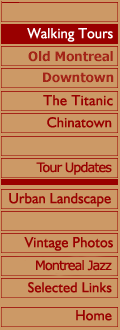 |
Montreal Chinatown (from The Guide to Ethnic Montreal by Barry Lazar and Tamsin Douglas)
Today, French, English, Cantonese, Mandarin, and Vietnamese are commonly heard in stores in Chinatown as well as Chinese provincial dialects like Fu-chian and Chao-chun. It's not unusual to see Canadian festivals celebrated in the area, with green fortune cookies on St. Patrick's Day or pink bean curd hearts on Valentine's Day. |
||||||
START AT THE CHAMP-DE-MARS MÉTRO STATION The Champ-de-Mars refers to the Roman god of war and is a common French name for militia marching grounds. This land was acquired by the Jesuits at the end of the 17th century andwas used by the militia for drills. To the south is Old Montreal and the Saint Lawrence river. The large building with the green copper roof is the back of the City Hall of Montreal, 275 Notre Dame East. Built in 1878, a fire destroyed most of it in 1922. It was rebuilt in the Beaux-Arts style popular at the time. The front is quite elaborate. To the west is the Palais des Congrès Montreal's convention centre, and the Place-d'Armes Métro where the tour ends. Once you leave the métro station walk west along Viger Avenue for one block to Ste-Elisabeth.
Centre Hospitalier Saint-Charles Borromée is on the north side of de la Gauchetière between de Bullion and St-Dominique. This was originally the Montreal General Hospital and the oldest part of the building dates from 1821. (In 1949, land was acquired north of the downtown area on the slopes of Mount Royal where a new Montreal General Hospital was built). In 1956, this building reopened as a seniors' home; in 1968 it became a hospital for long term care and adult rehabilitation. The Montreal Pentecostal Church is at 100 de la Gauchetière E. The Chinese United Centre Building is at 1001 St-Dominique. It was built in 1984.
During the 1940s, this was the seamiest side of the city. One columnist wrote "whether you're looking for a gal or gun, haircut or a hustler, a hock shop or a hamburger–you'll find it on St. Lawrence boulevard. The area stagnated for decades. However, there have been many positive changes in the past few years. Vietnamese and new immigrants from Hong Kong have taken over much of St-Laurent between Viger and René-Lévesque. On Sundays, the district has a marvellous bazaar-like atmosphere. Grocers extend their stores onto the sidewalk with fresh fruits, imported canned goods, and crates of thousand-year-old eggs (actually, eggs which have been potted for about a month). On festival days such as the August Moon, there are dragon dances, martial arts demonstrations, games of Chinese chess, and of course, firecrackers." The Dart Coon Club is upstairs at 1972 St-Laurent. This organization is now a social club but was once part of the military arm of a now-defunct political group based in China known as the Free Mason Society. The Chinese Free Masons were not linked to the international fraternal movement of Free Masons.
There is a tiny courtyard fronted by Chinese-style wrought-iron gates between 64 and 70 de la Gauchetière. The oldest grocery store in the area is Sun Ling Lung at 72A de la Gauchetière W. Several of the Chinese clans or family associations have social rooms on the second and third floors of the older buildings. One of the largest is the Lee Association at 90 de la Gauchetière. 112 de la Gauchetière was originally the Chevra Shaas synagogue built in 1905. From 1940 to 1962 it was the site of the Montreal Chinese Hospital. Clark Street is the only north-south block which still conveys a sense of the old community with its many rooming houses, shops, and private residences. Almost all of that first generation of stores and restaurants are gone. Two of the oldest, Leong Jung Produce and the Sun Sun restaurant closed recently, unable to compete with the new generation of Asian entrepreneurs. 100l Clark is the office of the practically moribund Chinese Nationalist League of Canada, a final whisper of the hope that Taiwan's government would eventually rule in Beijing. It's now a men's social club. The Chinese United Centre on de la Gauchetière hopes to build a seven-story cultural centre at 1086 Clark. The Wing Building at the corner of de la Gauchetière and Coté may be the oldest building in Chinatown. It was built in 1826 by James O'Donnel, the architect of Notre Dame Basilica in Old Montreal. The Wing Building has been a military school, a paper boxfactory, and warehouse. Wing Hing Lung is a Chinese expression for "a long life" and Wing's is known for its fortune cookies and noodles. The company was founded by Arthur Lee who was born in Chinatown over seventy years ago. |
|||||||
|
| Downtown Montreal Guide | Old Montreal Guide | Guide to Eating Out | | Walking Tours | Urban Landscape | Guide to Literary Montreal | | Montreal Vintage Photos | Montreal Links | Montreal Jazz | www.vehiculepress.com © Véhicule Press, All Rights Reserved |

